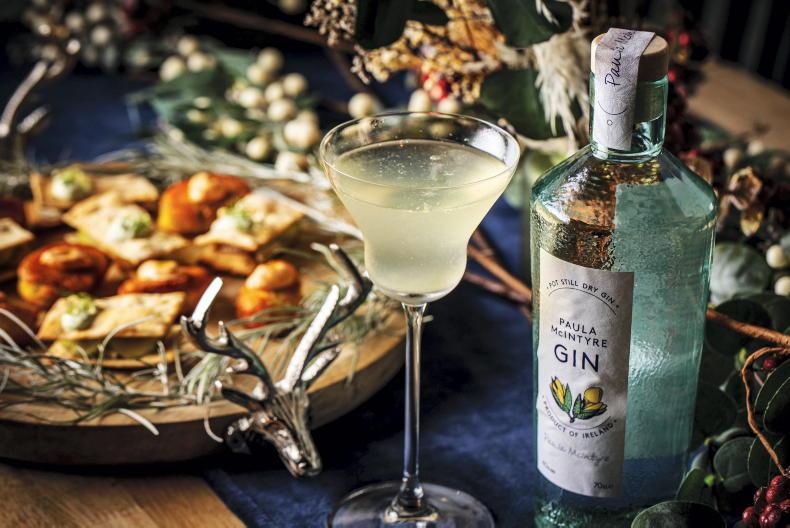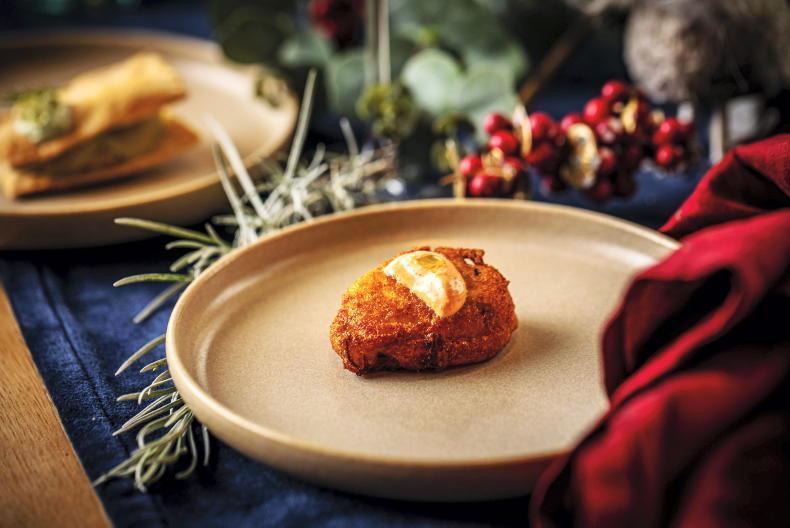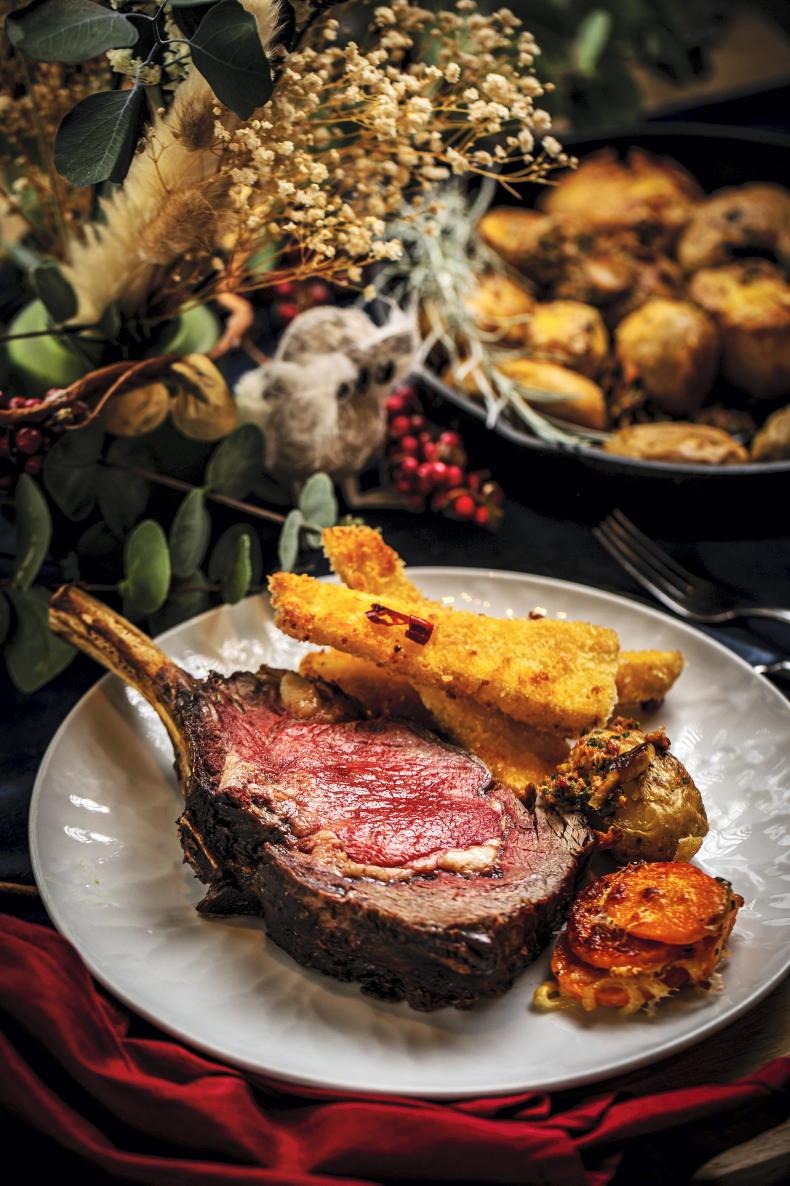
LOYALTY CODE:
The paper code cannot be redeemed when browsing in private/incognito mode. Please go to a normal browser window and enter the code there

LOYALTY CODE:
The paper code cannot be redeemed when browsing in private/incognito mode. Please go to a normal browser window and enter the code there
This content is copyright protected!
However, if you would like to share the information in this article, you may use the headline, summary and link below:
Title: Dinner with Paula
This Christmas, Co Derry chef and television presenter Paula McIntyre is all about breaking with tradition, while still making use of great local produce, writes Janine Kennedy.
https://www.farmersjournal.ie/dinner-with-paula-843033

ENTER YOUR LOYALTY CODE:
The reader loyalty code gives you full access to the site from when you enter it until the following Wednesday at 9pm. Find your unique code on the back page of Irish Country Living every week.

CODE ACCEPTED

You have full access to farmersjournal.ie on this browser until 9pm next Wednesday. Thank you for buying the paper and using the code.

CODE NOT VALID
Please try again or contact us.
For assistance, call 01 4199525
or email subs@farmersjournal.ie
Sign in

Incorrect details
Please try again or reset password
If would like to speak to a member of
our team, please call us on 01-4199525
Reset
password
Please enter your email address and we
will send you a link to reset your password

If would like to speak to a member of
our team, please call us on 01-4199525
Link sent to
your email
address
![]()
We have sent an email to your address.
Please click on the link in this email to reset
your password. If you can't find it in your inbox,
please check your spam folder. If you can't
find the email, please call us on 01-4199525.
![]()
Email address
not recognised
There is no subscription associated with this email
address. To read our subscriber-only content.
please subscribe or use the reader loyalty code.
If would like to speak to a member of
our team, please call us on 01-4199525
 This is a subscriber-only article
This is a subscriber-only article
Update Success !

If you ever find yourself visiting Northern Irish chef and television presenter Paula McIntyre, don’t bother eating breakfast – you are going to be fed.
Hospitality comes naturally to Paula, who grew up with simple and tasty Co Derry fare at home. For college, she studied culinary arts in both Belfast and the United States before working her way through some of Northern Ireland’s top kitchens. Now, Paula hosts her BBC One Northern Ireland programme, Paula McIntyre’s Hamely Kitchen, where she highlights local foods and traditional Ulster Scots recipes in a nod to her cultural roots.
This past year, Paula filmed a special series in the United States. She visited Maine, New Hampshire, Tennessee and Kentucky, where she explored the cuisine and heritage of the Americans living in these areas.
“I always wanted to do an American series,” she says. “I never thought it would really happen, but this year it did. We were following the journey of the Ulster Scots and Irish when they first arrived in America.”
Filming highlights included hanging out with Dolly Parton’s sister (“She made her ‘slaw of many colours’,” Paula recalls, laughing) and meeting a man whose family had emigrated from Northern Ireland in 1718 and who still kept artefacts from his ancestors.
“They were from the town I grew up beside,” Paula says. “His wife made the crew some blueberry pie – I still think about how delicious it was. I really felt a connection with them, because at the end of the day we’re all involved in food – that’s the bond, isn’t it?”
You can catch episodes of Paula’s American adventures on the BBC iPlayer app. But speaking of connections, Paula is also considered a local food champion in her home county. She regularly features and collaborates with local farmers and producers.
One of these connections turned into a new business venture when Basalt Distillery asked Paula if she would like to create a special gin.
“We brought the gin out last year,” she says. “Basalt Distillery started out in 2020, it’s run by a young couple, James Richardson and Martha Garbe. They approached me and said ‘You come up with the flavours you want’.
“I love gorse, so we went with gorse, meadowsweet, elderflower and a touch of lemon verbena.”
The gin was a success, and last November the trio decided to also develop a special rum. Paula went on an exploration journey once again and chose a delicious flavour profile of blackberry and raw honey from nearby Ballybannon (in the Mourne Mountains).
“The bees up there have access to blackberry bushes and gorse,” she explains. “It really is the perfect complement to the blackberry rum.”
For this Irish Country Living Food recipe spread, Paula wanted to share a Christmas dinner alternative to the traditional turkey, while still featuring as much local produce, dairy and meat as possible – a true taste of Northern Ireland.

Makes one cocktail
Paula will be enjoying some of her own gin this festive season and one of her favourite ways to enjoy is in this classic cocktail, the French 75. Ideal for celebratory holiday drinks or the perfect aperatif to your big Christmas feast; this cocktail isn’t too sweet but is full of flavour thanks to the many botanicals in Paula’s gin.
For the sugar syrup:
100ml water
50g caster sugar
To assemble:
35ml Paula McIntyre Gin
15ml freshly squeezed lemon juice
Champagne or sparkling wine, to top
1 Place the water and sugar in a small saucepan and simmer gently until the sugar has completely dissolved (about 5-8 minutes) – you do not want any caramelisation to occur. Once the sugar has dissolved completely, remove from the heat and let it cool to room temperature (this will keep in the fridge for up a month).
2 Make the French 75: fill a cocktail shaker with ice and add 2tsp of the sugar syrup, the lemon juice and the gin. Shake vigorously for 10 seconds, then strain into a champagne flute or coupé.
3 Top with the sparkling wine and give a gentle stir to mix. Serve immediately, while perfectly chilled.
nibbles

Serves 6
Mackerel is found seasonally in Northern Irish waters and is Paula’s favourite fish, especially for making pâté. The creamy Chestnutt’s Farm yogurt and dill cut through the smoky fish, while the Burren Balsamics citrus pearls add the perfect pop of acidity.
For the cider and pumpkin seed crackers:
175g plain flour
45g butter
1½ tsp baking powder
2 tbsp finely ground pumpkin seeds
70ml dry cider
½ tsp salt
For the pickled cucumber:
1 cucumber
75ml water
75ml cider vinegar
35g caster sugar
½ tsp salt
¼ tsp turmeric
A handful of fresh dill, chopped
1 tsp toasted mustard seeds
For the smoked mackerel pâté:
250g smoked mackerel fillet, skin removed
125g cream cheese
50g crème fraiche
1 tsp Dijon mustard
Zest and juice of ½ lemon
Pepper, to taste
For the dill yogurt:
200g Chestnutt’s Farm Greek style yoghurt
2 tbsp fresh dill, finely chopped
Salt and pepper, to taste
To serve:
1 small jar Burren Balsamics Citrus pearls
Dill fronds
1 First, make the crackers. In a large bowl, rub the flour and butter together into a fine crumb consistency. Mix in the baking powder, finely ground pumpkin seeds and salt. Make a well in the centre and mix in the cider to form a dough. Wrap in parchment and chill for an hour.
2 Preheat the oven to 180°C. Divide the chilled dough in half and, on a floured surface, roll as thinly as you can. Cut into desired shapes and place on parchment-lined baking trays. Bake for about 12 minutes, or until crisp and golden. Cool on a wire rack and store in an airtight container for up to a week.
3 Make the pickled cucumber: slice the cucumber in half lengthwise and scoop out the seeds. Finely slice and place into a clean jar with the chopped dill.
4 To make the pickling liquid, bring the water, vinegar, turmeric, sugar and salt to a boil until the sugar is dissolved. Pour the hot liquid directly over the cucumber and dill. Seal the jar, cool at room temperature and chill before using.
5 Make the smoked mackerel pâté: place the mackerel, crème fraiche, cream cheese, Dijon and lemon into a food processor and pulse until you make a smooth paste. Season to taste with salt and pepper and chill until ready to use.
6 Make the dill yogurt: add the dill and yogurt to a blender and blitz until smooth. Season to taste with salt and pepper, spoon into a squeezy bottle and chill until ready to use.
7 To assemble, spread some smoked mackerel pate on a cracker and top with some cucumber pickle. Place another cracker on top and dot with some of the dill yogurt. Add a few balsamic pearls and some dill fronds to garnish.

Serves 6
Paula has been inspired by her recent travels in the US where hush puppies are a regular feature on the tables of the American south. Chestnutt’s Farm is run by the Chestnutt family near Portrush, where they milk their 250-strong herd and sell directly to the public, as well as making their delicious Greek-style yogurt
For the hush puppies:
100g cornmeal
50g plain flour
1 tsp onion powder
2 scallions, finely chopped
½ tsp salt
1 tsp baking powder
35g mature cheddar, grated
1 egg
100ml buttermilk
Oil, for frying
For the chilli yogurt:
1 red chilli, deseeded and chopped
1 shallot, finely chopped
1 clove garlic, minced
2 tsp tomato puree
1 tbsp Broighter Gold rapeseed oil
200g Chestnutt’s Farm Greek style yoghurt
Salt, to taste
For the scallion oil:
4 scallions, green parts only, finely chopped
50ml Broighter Gold rapeseed oil
1 Make the hush puppies: in a large bowl, add the cornmeal, flour, onion powder, scallions, salt and baking powder. Whisk to combine. In a separate bowl, whisk the egg and buttermilk. Mix this into the dry ingredients, then fold in the cheese.
2 If you have a deep fat fryer, set the temperature to 170°C. If you don’t, heat approximately 5cm (in depth) of frying oil into a heavy-bottomed, high-sided pan or skillet. To test whether it’s ready, drop a teaspoon of the mixture into the pan – if it sizzles, it’s ready.
3 Preheat the oven to 100°C and line a baking tray with parchment. Drop batter into the pan by the heaped tablespoon, ensuring you don’t overcrowd the pan, and cook the hush puppies for 2 minutes on each side. Drain on kitchen paper before placing the hush puppies in the warm oven, then repeat the process until all the batter is used.
4 Make the chilli yogurt: cook the chopped chilli, shallot and garlic in rapeseed oil over a gentle heat for a few minutes, until translucent. Add the tomato puree and cook for an additional minute. Cool completely, then blend with the yoghurt and season to taste.
5 Make the scallion oil: place the scallions in boiling, salted water for 20 seconds, then remove with a slotted spoon into a bowl of iced water. Drain well and pat dry. Blend with the oil. Place a sheet of muslin in a sieve over a bowl and add scallion mixture. Allow to strain.
6 To serve, top each warm hush puppy with a dollop of the yoghurt, then add a few drops of scallion oil. Alternatively, you can serve these hot with a fine grating of good-quality Parmesan or Cais na Tire cheese.

Serves 6-8
Moiled – or “Moilie” cattle are a native Irish breed, originally used for both milk and beef. Paula sources her beef from Moyletra Moileds (moilies.co.uk), which are farmed on the nearby Causeway Coast by David and Sandra Scott. A third-generation family farm, Moiled cattle would have been farmed there up to the 1950s, before being brought back by David and Sandra in 2019.
3kg rib of beef on the bone
2 tbsp Broighter Gold rapeseed oil
Salt, to season
2 onions, peeled and quartered
Few sprigs fresh thyme
500ml beef stock
75ml whiskey
25ml Burren Balsamics roast onion vinegar
1 Preheat your oven to 200°C and set aside a roasting tray until ready to use.
2 Heat 1 tbsp of oil in a large frying pan on medium high until smoking hot. Season the beef liberally with salt and sear in the hot pan until a deep brown colour is developed on all sides of the roast.
3 Place the quartered onions into the roasting tray and set the seared beef roast on top. Drizzle over the remaining oil and add a few sprigs of fresh thyme to the tray, as well. Place in the preheated oven and roast for approximately 75 minutes for a medium rare doneness. Use a temperature probe – you want an internal temperature of 65°C for medium rare (75-80°C for well done).
4 Remove the beef from the oven, wrap it loosely in foil and let rest for 20 minutes while you make the gravy. Add the beef stock, whiskey and balsamic vinegar to the roasting tin. Either scrape the tin and empty the contents into a saucepan or place the roasting tray directly on the hob.
5 Gently simmer until the liquid has reduced by half. Remove the sprigs of thyme and blend the liquid with the onions. Pass through a sieve and check for seasoning, adding more salt and pepper, if needed.
6 Place the beef on a platter. Serve hot with the gravy.

Serves 6-8
When it comes to potatoes, Paula always sources hers from nearby McCurdy’s Farm which is located near White Park Bay on the north coast. Find a local farmer, or try Ballymakenny Farm in Co Louth, or Horner’s Farm Shop in Co Down.
18 medium potatoes (floury type)
Olive oil, for drizzling
Sea salt
For the bacon brown butter:
100g smoked bacon lardons
2 shallots, finely chopped
2 cloves garlic, finely sliced
100ml dry cider
200g butter
2 tbsp finely chopped chives
6 cooked chestnuts
1 Preheat the oven to 200°C. Scrub the potatoes and boil, skin on, in salted water for 20 minutes. Drain, return to the pan and dry out on a low heat for five minutes.
2 Drizzle the oil onto the base of a roasting tray and add the potatoes. Place a tea towel on top and punch the potatoes slightly to break the skin. Remove the tea towel and drizzle with a bit more oil. Season with salt.
3 Place in the oven and roast for 45 minutes – until the potatoes have cooked through and are crisp on top.
4 Cook the bacon in a dry pan until golden and crisp. Add the shallots and garlic and cook until golden. Add the cider and boil until all the liquid has evaporated.
5 Cut the butter into cubes and place in a pan. Cook the butter until the foam starts to subside and it smells nutty, this will take a few minutes of watching. Pour into a heat-proof bowl and cool to room temperature.
6 Blend the cooled brown butter with the bacon mixture to a smooth purée. Fold in the chopped chives. Shape the butter into a cylinder, wrap in parchment paper and chill.
7 Slice the butter and dot approximately 75g over the top of the potatoes. Return to the oven for five minutes. Finely slice the chestnuts and sprinkle over the top.

Serves 6-8
Irish carrots are plentiful at Christmas time, so try to source yours from a local farmer or ensure your supermarket carrots carry the Bord Bia Quality Assured mark. Paula sources her carrots from farmers Leona and Richard Kane in Co Derry, who also produce Broighter Gold Rapeseed Oil.
500g carrots, peeled and finely sliced
2 onions, peeled and finely sliced
50g butter
500ml chicken or vegetable stock
125ml double cream
1 tbsp wholegrain mustard
Handful of chopped parsley
75g mature cheddar, grated
1 Preheat the oven to 200°C. Butter a casserole dish and set aside until ready to use.
2 Melt the butter in a large saucepan and add the carrots; cooking gently for about 5 minutes and stirring frequently. Add the onions and cook for an additional 5 minutes, before pouring the stock over and covering with a circle of parchment paper.
3 Simmer gently until the carrots are just fork tender, then strain (making sure you keep all the cooking liquid) and place the carrots in the buttered casserole dish.
4 Bring the cooking liquid back up to a simmer and reduce until thickened (you want it to coat the back of a spoon). Add the cream, parsley and mustard and simmer for an additional 5 minutes. Pour this over the carrots and sprinkle the cheddar on top.
5 Bake in the preheated oven for approximately 15 minutes, or until golden and bubbling. Serve hot.




SHARING OPTIONS: